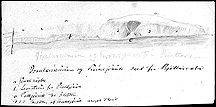| Date: | 1844-5. |
| Form: | Three stanzas, each containing four three-stress lines with the rhyme scheme AbCb and the alliteration pattern 22. |
| Manuscript: | KG 31 b I, the earlier copy (facsimile KJH282; image) and KG 31 a II, the later copy (facsimile KJH281; image), in neither of which the poem bears a title. |
| First published: | 1847 (A240-1; image) under the title "Réttarvatn" ("Sheepfold Tarn"). |
On 20 September 1841, during his last journey along this route, returning south to Reykjavík after attending Bjarni Thorarensen's funeral, Jónas camped at Sheepfold Tarn to study the geology of the immediate area (2E389) and made the sketch reproduced above. The poem may preserve memories of this visit.
